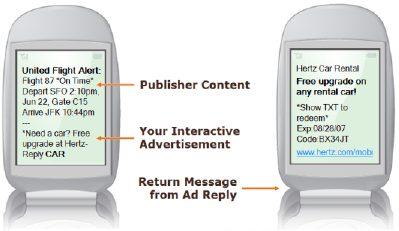New media consultant and columnist Steve Smith speculated recently in MediaPost that we will soon be receiving many more sponsored messages with our cell phone’s text bulletins. These text bulletins, also known as SMS messages, are the 140-character packets that helped Justine Ezarik rack up a 300-page AT&T cell phone bill. (She reports that Twitter and the SMS feature of Facebook were the biggest culprits. Each message sent and received was separately itemized.)
The good news is these messages will be extremely targeted, and are “opted into” in exchange for the content received. An example cited by Smith is NASCAR race updates, sent to the 200,000 subscribers to this branded program. He explains that if a supermarket chain would want to target those interested in NASCAR, “There is enough mass there to net perhaps 80,000 users in a general geographic region.”
That’s enough to make quite an impact. Especially since response rates are impressively high.
Although the initial calls to action must be quite brief — 20 to 80 characters — the extremely targeted nature of the messages helps response. A “response” is usually hitting reply, to receive a full (up to 140 characters) expansion of the offer and a URL to click on. This graphic , provided by the MoVoxx site, helps illustrate the typical process:

Alec Andronikov, who is the managing partner of MoVoxx, says that of the many billions of SMS messages sent each month, somewhere around 500 million of them are some kind of publisher-pushed alert. And each could conceivably be sponsored. Smith continues:
Right now, [Andronikov] claims about 3.5 million uniques with sports, travel, dating and newspapers comprising the largest content categories. … Andronikov claims a response rate of 2.5% to 4% on the SMS ads.
That means a hypothetical, regionally-based supermarket chain running a NASCAR promotion could get their entire message in front of at least 2,000 fans (80,000 recipients of the initial, sponsored message multiplied by a 2.5% response rate). If the offer is compelling enough, this can win the chain hundreds of new customers.
The ability to target consumers by age, gender and zip code — as well as areas of personal interest, as implied by the content to which a consumer subscribes — promises a way to take the junk out of junk text messages.
Through testing we’ll soon see whether these campaigns “have legs” — whether they can generate enough of a return on investment to make them a smart, new marketing tactic.